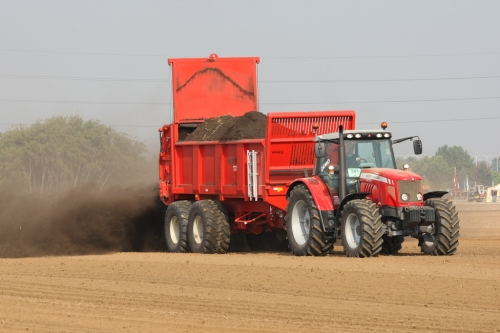Fall manure application tips
Maximize value and limit risks this fall through careful manure application.

Manure is a valuable resource on the farm and autumn provides a break in the cropping cycle that many growers dedicate to manure application. Fall application is convenient, and when managed properly can effectively deliver manure nutrients to a spring crop. However, if late-season application is mismanaged nutrients can be wasted, water quality degraded and neighbors angered. Care is required to insure that the risks associated with fall manure application are minimized.
Photo: A grower spreads solid manure on a field. Photo credit: eutrophication&hypoxia on Flickr.com
Test your soil and manure
Both manure and the soil to which it will be applied require nutrient analysis. Testing is essential to determine nutrient concentrations and avoid over or under application. Manure should be analyzed for percent dry matter (solids), ammonium nitrogen (NH4-N), total nitrogen (N), phosphorus (P) and potassium (K).
A list of Midwest labs that test manure can be found below. MSU Soil and Plant Nutrient Lab offers a basic soil analysis that includes P, K and magnesium (Mg) concentrations as well as N, phosphate (P2O5) and potassium (K2O) fertilizer recommendations based on crop selection and yield goals. A soil nitrate concentration can be added for an additional fee. See your local Extension office for access to soil testing services.
Manure Testing Laboratories
Litchfield Analytical Services
P.O. Box 457
535 Marshall St.
Litchfield, MI 49252
(517) 542-2915
University of Wisconsin Extension Soil & Forage Analysis Lab
8396 Yellowstone Dr.
Marshfield, WI 54449
(715) 387-2523
Midwest Feed Testing Service
3025 Brand Ave.
Clare, MI 48617
(517) 386-2677
A & L Great Lakes Laboratories, Inc.
3505 Conestoga Dr.
Fort Wayne, IN 46808-4413
(260) 483-4759
Spectrum Analytic, Inc.
P.O. Box 639
1087 Jamison Rd.
Washington Courthouse, OH 43160
(800) 321-1562
Holmes Laboratory, Inc.
3559 U.S. Rt. 62
Millersburg, OH 44654
(800) 344-1101
Determine application rates according to nutrient needs
A soil test will tell you how much of each nutrient to apply, but manure cannot be directly substituted for synthetic fertilizers. This is because only a fraction of the total nutrient contained in manure exists in forms available to plants. The rest is held in organic molecules that must undergo decomposition to be made available. The results of a manure analysis can be used to determine what portion of your manure’s fertility will be available in the first growing season. Several free tools are available to assist in these calculations including the Manure Nutrient Availability Calculator from Purdue University. The agronomic N, P2O5 and K2O recommendations given in a soil analysis report should not be exceeded by the amount of available macronutrients added as manure and/or other fertilizer sources.
Calibrate application equipment
The amount of manure applied to a field in gallons or tons per acre must be known to ensure accurate fertilization. The capacity of a spreader is available in documentation or on the equipment itself. If spreader capacity is unknown, loads can be weighed and the weight divided by density to determine gallons per acre applied. Track the number of loads applied to each field to zero in on the target rate. Manure should be spread as evenly as possible across a field. Determining the correct traffic pattern to accomplish this requires adaptation of driving speed, spreading width and overlap as the loads are counted out.
Time and locate application appropriately
In autumn, manure should be applied when soil temperatures are between 50 degrees F and 35 degrees F. Waiting until the soil cools limits nitrogen volatilization, protecting fertilizer value. According to MDARD, manure cannot be spread within 150 feet of surface waters unless it is incorporated within 48 hours. Application of manure to frozen snow-covered soils often contributes to surface runoff and is therefore not recommended by Michigan State University Extension. If manure must be spread in winter, applicators should avoid fields with greater than three percent slope and/or course textured soils.
Incorporate manure and record application
If not injected, manure should be incorporated immediately after spreading. Incorporation limits volatilization to preserve the nitrogen value of the manure and prevent odor complaints. After application take a minute to record your actions for future reference. A manure application record should include:
- soil fertility test reports
- manure analysis reports
- date(s) of manure application(s)
- rate of manure applied (e.g., gallons or wet tons per acre)
- previous crops grown on the field
- yields of past harvested crops



 Print
Print Email
Email


